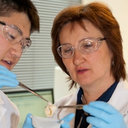Lysine-enhanced glutaraldehyde crosslinking of collagenous biomaterials.
Keywords
Abstract
Crosslinking of collagenous biomaterials currently employs the use of glutaraldehyde. The putative enhancement of glutaraldehyde crosslinking by lysine was investigated in three model systems: bovine pericardium, collagen membranes, and bovine serum albumin. Repetitive sequential treatment of bovine pericardium with glutaraldehyde and lysine and finally with formaldehyde produced a matrix which, by the two criteria used (shrinkage temperature and urea/SDS soluble collagen), was shown to be more highly crosslinked than pericardium fixed in glutaraldehyde alone. Essentially the same results were obtained when membranes prepared from pepsin-soluble pericardial collagen were subjected to sequential glutaraldehyde and lysine treatments, reaching shrinkage temperatures of more than 90 degrees C. Heart valves prepared from lysine-enhanced glutaraldehyde crosslinked bovine pericardium were tested in vitro in an accelerated fatigue tester and have been shown to behave satisfactorily after 300 million cycles. These additional crosslinks proved to be stable in saline at 37 degrees C. Studies on bovine serum albumin attempted to get an insight into the mechanisms of lysine enhancement of glutaraldehyde crosslinking by treating sequentially albumin with glutaraldehyde and lysine and analysis of the products by gel filtration and SDS-PAGE. These studies suggest that free amino groups exposed by proteins are initially reacted with glutaraldehyde and then bridged by the diamino compound (lysine) producing more extensive intermolecular crosslinking than glutaraldehyde alone.


